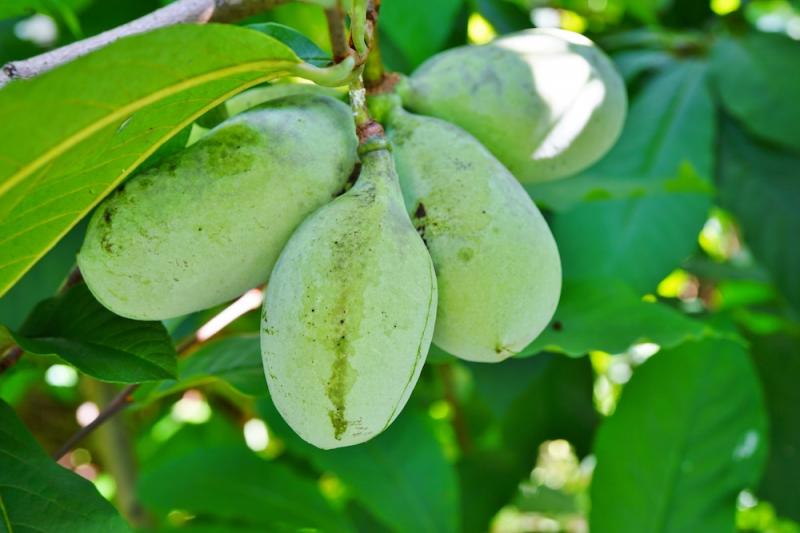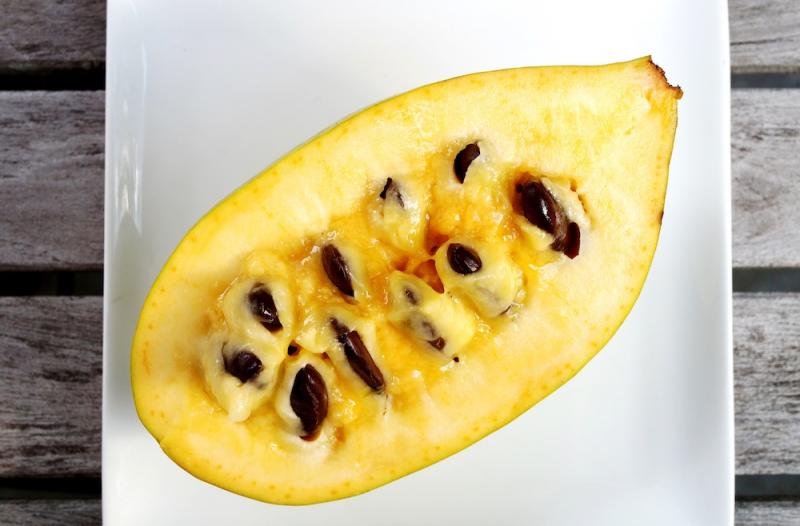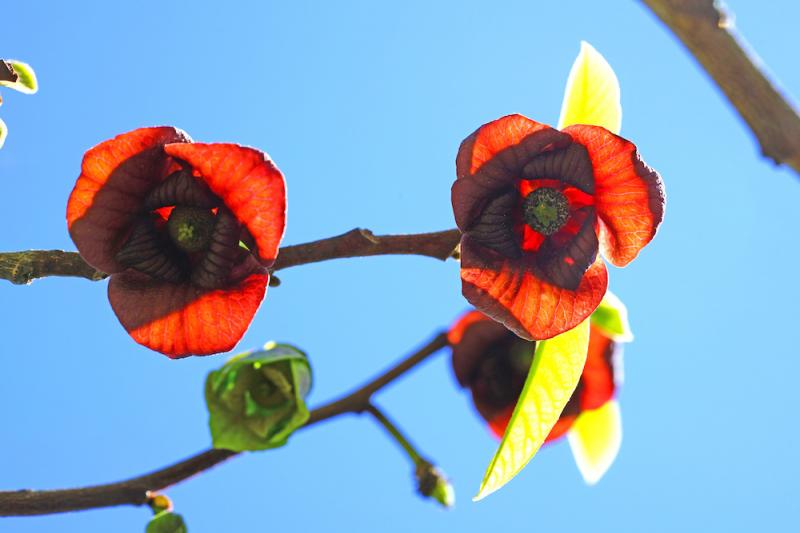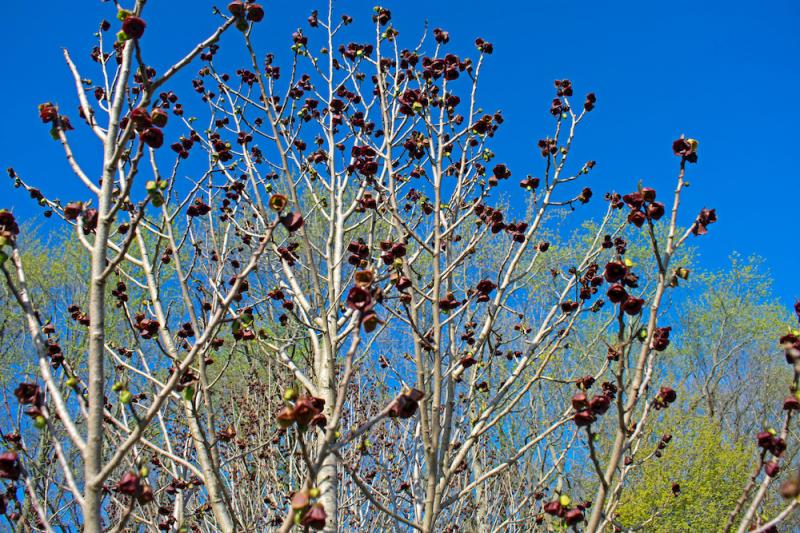
The American paw paw (Asimina triloba) is a deciduous tree native to the eastern United States and Canada. It is the only temperate member of the family Annonacea. All the other plants in this family grow in tropical or subtropical climates and a number of these are used medicinally, including cherimoya, graviola (sweetsop), and ylang-ylang.
While paw paw does produce edible fruits, we’re more interested in how it can be used as a medicine. Like many other members of the Annonacea family, paw paw contains compounds known as annonaceous acetogens. These are long chain fatty acids and there are about 50 of them in paw paw. They are also found to a lesser degree in graviola.
Paw Paw and Acetogenins for Cancer
Years of research by Dr. Jerry McLaughlin proved that these compounds are powerful cytotoxic agents. They work by slowing the production of ATP in the cells.
This not only helps cancer cells die, it also prevents the growth of new blood vessels in or near tumors and slows down the replication of DNA and RNA ,which blocks the rapid growth of cancer cells. It’s also helpful for restoring the effectiveness of chemotherapy drugs that have become resistant to chemotherapy. It blocks the ATP-activated metabolic pumps that allow the cancer cells to reject the chemotherapy drugs. These acetogenins are 300 times more potent than Taxol but less toxic, and they do not cause weight loss.
McLaughlin’s research group published over 100 papers on these paw paw compounds. Here are links to some articles from the Journal of Natural Products summarizing this research—Annonaceouos Acetogens: Recent Progress and Paw Paw and Cancer: Annonaceous Acetogenins from Discovery to Commercial Products.
Using a Paw Paw Standardized Extract
 In his research, Dr. McLaughlin found that the amount of these acetogenins can vary widely in different parts of the plant and at different seasons of the year. The highest amount of these compounds is found in the twigs in the spring, the unripe fruit, and the ripe seeds. Because of the variation in acetogenin content, this is one situation where a standardized extract is preferable. Two capsules of the extract contain 17 mg of acetogenins.
In his research, Dr. McLaughlin found that the amount of these acetogenins can vary widely in different parts of the plant and at different seasons of the year. The highest amount of these compounds is found in the twigs in the spring, the unripe fruit, and the ripe seeds. Because of the variation in acetogenin content, this is one situation where a standardized extract is preferable. Two capsules of the extract contain 17 mg of acetogenins.
The suggested starting dose is four capsules per day and if that dose is tolerated, you can increase the dose every three or four days by another two capsules, up to about 20-24 per day spaced at equal intervals throughout the day. If you start to experience nausea or fatigue, lower the dose. Lower doses (two to six capsules) can be taken along with chemotherapy to enhance its effectiveness.
Paw Paw Extract Safety
Paw paw is much safer than most chemotherapy drugs. In early research, it was discovered that paw paw extract was consistently vomited up before quantities that could cause serious problems to healthy cells could be consumed. In a toxicology study using dogs, they were unable to give the dogs a dose sufficient to cause death. The dogs would simply vomit first.
One of the main problems with traditional cancer therapies such as radiation and chemotherapy is that they damage healthy cells as well as cancer cells. They especially target fast-growing cells, which is why they often lower white blood cell production, inhibit hair growth, and adversely affect the cells lining the intestines as all of these are rapidly growing cells.
So, the question naturally arises, if acetogenins block ATP production, wouldn't that affect healthy cells, too? Well, it does slow down the function of healthy cells, but since the cancer cells use energy at a rate up to 17 times faster than normal cells, the compounds have the strongest effect against the rapid metabolism of the cancer cells. The abnormal cancer cells are induced to self-destruct through a process known as apoptosis, or preprogrammed cell death. Research suggests that the acetogenins in paw paw cause far less damage to healthy cells than most chemotherapy drugs.
Therapeutic Results with Paw Paw Extract
 Before being released, this paw paw extract was provided to 130 cancer patients for up to one and a half years. Only three of those in the study reported nausea and vomiting and one reported itching. None had any typical chemotherapy problems such as bone marrow supression, anemia, or hair loss.
Before being released, this paw paw extract was provided to 130 cancer patients for up to one and a half years. Only three of those in the study reported nausea and vomiting and one reported itching. None had any typical chemotherapy problems such as bone marrow supression, anemia, or hair loss.
Based on this research, it is typical to see significant reductions in tumor size and in tumor antigen levels within six to eight weeks. Some people report a more rapid, measurable response to the program. For instance, one lady saw an improvement in her CA-125 markers after only one week. (Cancer Antigen 125 is used to monitor ovarian cancer.)
In a patient with non-Hodgkins lymphoma, who had undergone three rounds of chemotherapy in six and a half years, the white cell count and lymphocytes returned to normal ranges after only 35 days of taking paw paw extract.
People who have cancer who have taken an acetogenins extract have also reported increased energy levels. This is because paw paw’s inhibiting effect on the metabolism of cancer cells means that healthy cells no longer have to compete with cancer cells for energy.
Paw Paw Extract Cautions
Paw paw should only be used with cancer, viral disorders, parasites, or other specific health problems. Paw paw should never be used for cancer prevention. Once a person’s cancer is in remission they should discontinue taking it.
Paw Paw isn't a stand-alone cancer therapy. It’s best to use it as part of a comprehensive program. It can be helpful, but it isn’t a solution by itself.
Paw paw may also induce a healing crisis or cleansing reaction if cell die-off occurs too rapidly, which may require cleansing herbs to help the body detoxify.
While using this program, products that increase cellular vitality, especially those that increase energy metabolism, should be avoided. Antioxidants decrease the effectiveness of the paw paw extract. Supplements to be avoided include Co-Q10, alpha lipoic acid, chapparral, grape seed extract, N-acetyl cysteine, and green tea extracts.
Paw paw should only be used during pregnancy or while nursing under the advice of a professional health practitioner.
Other Uses for Paw Paw Extract
 Viruses require ATP for reproduction and yeast and parasites also have rapid metabolisms. Therefore, paw paw extract has been proven helpful for inhibiting chronic viral infections such as cold sores and shingles. It can also be helpful for yeast overgrowth and parasites in the intestinal tract.
Viruses require ATP for reproduction and yeast and parasites also have rapid metabolisms. Therefore, paw paw extract has been proven helpful for inhibiting chronic viral infections such as cold sores and shingles. It can also be helpful for yeast overgrowth and parasites in the intestinal tract.
The dose for these problems is one or two capsules per day along with other herbs to help the problem. So, you could combine it with other antivirals for chronic viral infections like lemon balm, St. John’s wort, black walnut, and yarrow. For fungal infections, you can combine it with pau d’arco, oregano, or thyme. For parasites, it can be combined with wormwood, sweet annie, garlic, and black walnut.
It can also be used as an escharotic, an agent used to get rid of moles and warts. You can make a simple escharatic ointment by mixing the contents of a capsule with a healing salve to form a paste. Escharotics should only be used under the direction of a skilled herbalist.
Theoretically, it could also be used as an insecticide in the garden, but you’d need to dissolve it into an oily substance as the extract is not water-soluble and is poorly dissolved in alcohol, too. Perhaps you could mix it with neem oil.
Beyond the Standardized Extract
 Many years ago I gave a presentation on the standardized paw paw extract at a conference of the American Herbalist Guild. Several students asked, how can you use the plant yourself and I kept saying, I don’t know. Finally, a Native American, sitting at the back of the room said, “If you turn off the recording, I’ll tell you.” It turns out she was from a tribe that wandered from one area to another trading and acting as healers, and they had a long tradition of using paw paw for cancer.
Many years ago I gave a presentation on the standardized paw paw extract at a conference of the American Herbalist Guild. Several students asked, how can you use the plant yourself and I kept saying, I don’t know. Finally, a Native American, sitting at the back of the room said, “If you turn off the recording, I’ll tell you.” It turns out she was from a tribe that wandered from one area to another trading and acting as healers, and they had a long tradition of using paw paw for cancer.
What was interesting is that they used the three plant parts that Dr. McLaughlin had spent years learning were richest in acetogenins, and they harvested them at the time of the year when the acetogenin content is highest.
For basic cancers, ones that produce some kind of visible presence on the surface (tumors that produce swelling or skin cancers) they used just the twigs. According to her, they harvested the twigs at the first full moon after the spring equinox, and picked the twigs that pointed upwards “towards Sky Father.”
For deeper and more difficult cancers, they also used the unripe fruit, which they harvested at the summer solstice. They mashed the unripe fruit and dried it like fruit leather. They also harvested seeds from the ripe fruits that had fallen to the ground in the fall or had been “gifted to Earth Mother” as she put it.
All parts of the plant were extracted using fermentation. This would be important because acetogenins are not water-soluble. I wouldn’t know how to ferment them, so I’d probably extract them in oil or glycerin these substances are good at extracting fat-soluble compounds. They used the twig extract by itself and made an extract of all three for the more problematic cancers.
Paw paw doesn’t grow where I live so I’ve never tried making my own extracts of it, but if I did have paw paw trees growing near me, I would certainly experiment with it. You can also purchase graviola products, which also contain acetogenins, but in lower amounts.
Use Paw Paw as Part of an Overall Program
If you want to learn more about paw paw several years ago I made a video with Kimberly Balas called The Power of Paw Paw. I also uploaded a member webinar I did with Dr. Kimberly Balas in 2012, An Integrated Approach to Fighting Cancer. The video has some sound issues, but it has great information about cancer and paw paw, including Kim’s three-step cancer therapy program which includes the use of paw paw extract.
Downloads
Steven's Articles
December
-

-
The Evidence for Berberine
A yellow alkaloid found in traditional infection-fighting…
-

-
The Sensible Use of Caffeinated Herbs
Kola nuts, guarana, and yerba mate and other herbs…
-

-
The Health Benefits and Problems with Coffee
This popular caffeinated beverage can be beneficial…
October
-

-
Understanding Caffeine & Cellular Adaptation
Preserving the power of caffeine's buzz and the…
September
-

-
Horseradish
A pungent spice for aiding protein metabolism…
-

-
Banaba or Crepe Myrtle
A beautiful tree from Southeast Asia whose leaves…
August
-

-
Monkeyflowers
Flower essences to help see ourselves more clearly…
-

-
Mariposa Lilies
Strengthening the bond between mother and child…
-

-
The Noble Bay Leaf
A common kitchen herb for aiding digestion and…
-

-
Epimedium: Horny Goat Weed
A circulatory stimulant and kidney yang tonic…
July
-

-
The Medicinal and Nutritional Benefits of Apricots
A nutritious fruit and valuable medicinal seed for coughs
-

-
Dogwoods
Asian dogwood is used to stop excessive discharge,…
June
-

-
Neem: The Village Pharmacy
A popular Ayurvedic remedy for dental and immune…
-

-
Spilanthes: The Toothache Plant
A traditional remedy for teeth and gums, as well…
-

-
Forsythia
An anti-inflammatory, fever-reducing, and infection fighting herb

